I really wanted to like Gunslinger Girl. Made by MADHOUSE, Directed by Morio Asaka of Chihayafuru and Card Captor Sakura: Clear Card fame, Gunslinger Girl has a simple but compelling premise: child soldiers. Little girls trained and conditioned to become assassins for the Italian government, forced to do their nations dirty work. Whether that be protection, espionage or outright murder, Gunslinger Girl takes something reprehensible and shoves it right into your face so you can’t ignore. And then it dives into how the girls themselves feel about their position, whether or not its so different from things we do right here in the real world. So with such a premise, and such a strong production team, what’s not to like? Well strap in my friend, because I have a few thousand words prepared just for you. And be warned, this review will contain minor spoilers for Gunslinger Girl.
(Disclaimer: I am working to make 50 the new “average”. 70 is not an average score people. 70 is above average. Carry on.)
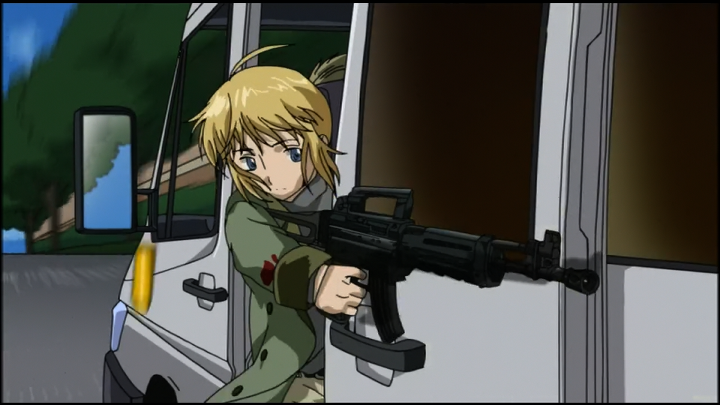
Animation/Art
As always, we have to start with Gunslinger Girl’s animation and art. Like many aspects of its production, this is a mixed bag, as Gunslinger Girls is is very inconsistent. Some episodes, when it wants to show off, it can look fantastic. The movement of the characters and the firefights are occasionally gorgeous. Each individual bullet can be seen exiting the chamber and falling to the floor as the heroine’s charge through the bad guys, the clothes shifting as they move or their weight and momentum carry through their movements. This is most often seen with Henrietta, with a great example being the opening mission in the first episode. No one can say that Gunslinger Girl doesn’t have the occasionally fantastic cut. But the issue is as I said before: the series is horribly inconsistent.
Outside of the occasional action scene every few episodes however, Gunslinger Girl is often stilted and motionless. Every character stands straight backed and stiff, without any real expressive character or even facial animation. Part of this can be chalked up to many of the characters actually having stunted emotions, and narratively thats fine. But you have to recognize what such a decision does to your visuals and account for that. The sad thing is that Gunslinger Girl isn’t even consistent on the action scenes. There are plenty of combat bits where we don’t get the stellar animation I mentioned previously. Rather everyone will stand still, the guns will flash and we will cut to all of the bad guys falling over. Now, this isn’t a deal breaker by any means, you don’t need stellar animation for a good story. But it certainly helps and Gunslinger Girl is hardly Monster.
Sadly Gunslinger Girls isn’t much better artwise and it has a very similar problem to its animation. The designs and proportions are much more… not necessarily realistic, but more accurate. I mentioned Monster before and Gunslinger Girl has a very similar visual style to it. The character have rather rectangular bodies, realistically sized proportions and it makes heavy use of greys and browns, with splashes of color occasionally thrown in to vary it up. However where Gunslinger Girl falls short is that just like its animation, the characters aren’t particularly expressive. Once again, having characters stripped of emotions works fine, so long as there are other characters who can emote around them. But when a majority of your cast is often blank faced or subdued in their expressions, it makes for a number of very dull scenes.
All in all, on paper Gunslinger Girl’s style is fine. I like how different it is from the more modern moe blobs or from A1 Picture generic faced protagonists. It reminds me fondly of series such as Monster and it gives Gunslinger Girls a more “real world” air. However it fails to make good use of this aesthetic nor does it do enough to “wow” the action junky in me. It isn’t terrible, I never thought the show looked ugly. But neither did it impress. And for a medium named around animation and the movement of characters, that’s a damn shame.
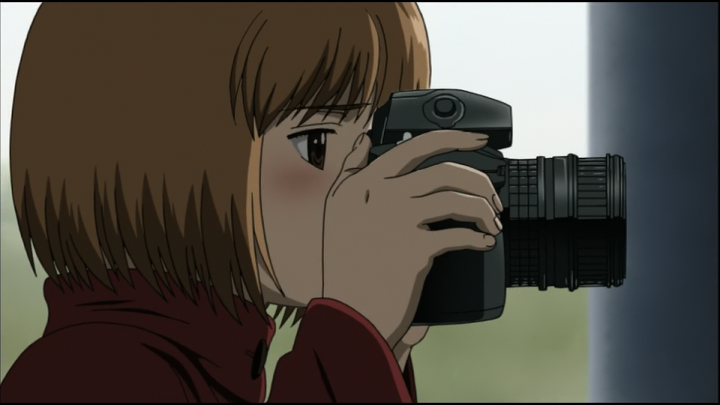
Direction
On the other end of the spectrum we have Gunslinger Girl’s direction. For all the faults I have with the production, I do think this was actually pretty good. Gunslinger Girl was often very inventive with its camera and there were some stunning shots through out. One of my favorites was an establishing shot of Florence, where the camera panned over the city in early morning before landing on pigeon filled square. It managed to set both the mood and the setting for the episode right from the get go without a single word of dialogue. This sort of scene isn’t alone either, there are plenty of these sorts of establishing shots throughout the series. From a rain-drenched pistol Henrietta’s camera to final scene of the entire series. As if this wasn’t enough though, Gunslinger Girl also does a great job of transitioning from these calm scenes to the action.
Simply put, Gunslinger Girl does a pretty good job of managing tension across its run. Of slowly ramping up to the climactic conclusion of an episode, of building up to it bit by bit. A great example of this comes in episode 3, where we are first introduced to Rico. The whole process of meeting the bell boy, his chat with Rico to the reveal and conclusion does a great job of keeping the viewers interest throughout. All in all, I would say that Gunslinger Girl’s direction does the lion’s share of the work in establishing its aesthetic. Of setting the mood and feel of every episode and carrying it through the season as a whole. So while the animation and art leaves something to be desired, this makes up for it. Just a little bit, at least.
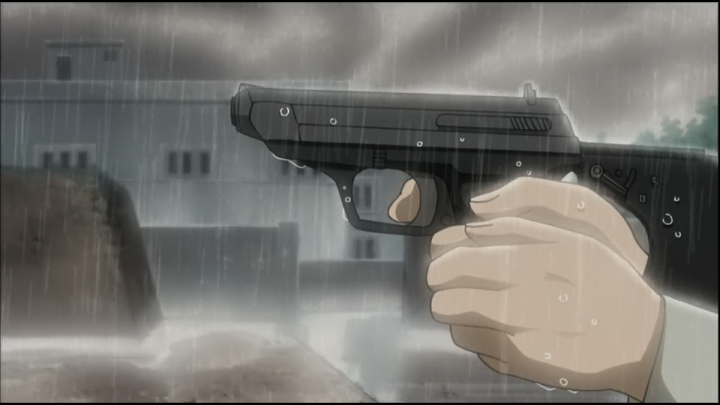
Setting/Story
And now we come to the story and this… this is where we start to run into some serious problems. Because it is here Gunslinger Girl makes it obvious that it is an incomplete adaptation of a (then) ongoing manga. The best way I can describe it is that Gunslinger Girl is an incredibly interesting setting and premise, but with the depth and follow through of a kiddy pool. As throughout the season the series is setting up so many different things, so many different plot threads. We have terrorists, we have internal politics, we have child soldiers and their own little drama, etc etc and the list goes on. It’s very obvious that we are being setup for a much longer story, that we are in it for the long haul… and yet as a single, individual season, none of these end up properly addressed. Only ever established.
This doesn’t necessarily have to be a bad thing, for an example you need look no further than Vinland Saga of last year. That is also a story that is much longer, where its initial season is effectively just a prologue. However unlike Vinland Saga, Gunslinger Girl has no clear bookend. In Vinland Saga there is a clearly established through line between Thorfinn and Askeladd, one that is both established and followed through to completion across the 24 episode season. In Gunslinger Girls however, there is really no equivalent through line. Our lead character Henrietta starts and ends the season effectively the same, with the only real difference being in how we the audience see her. There is Angelica I suppose, however her place in the story is so small that its hardly worthy of note. Sadly, there is just no real overarching narrative that effectively drives the season.
That said, its not as if there is nothing of value here. There are individual moments and episodes that are great and the general quality of the episodic stories is relatively high. Gunslinger Girl makes good use of the girls and how they relate to their handlers differently. Giving each of them a couple of one-off episodes that focus on them almost to the exclusion of everyone else. These episodes are often the most interesting by far, where we explore a new facet of what the handler/cyborg relationship means and how different people interpret it. Sadly, however good these episodes are individually, if they don’t feed into some overarching narrative then what’s really the point? This isn’t an action Shounen, it can’t ride by on hype fights and individual character moments.
The sad truth is that Gunslinger Girl never really does anything with it outside one fantastic moment with Elsa. Beyond that our leads are only ever represented as they are, with little in the way of meaningful changes. Yes we learn more about them, and as a viewer its a sometimes interesting exploration of child soldiers and the sorts of platonic relationships children can have with their parental figures. But it’s just not enough to really keep my interest. Not when we have the occasional episode that comes in and reminds us of a greater plot in the wider narrative. For instance you can’t just introduce a named bomb-making couple early on in the series and then never actually use them for anything. You can’t introduce the inter-agency politics and then end the season without any meaningful conclusion. And Gunslinger Girl is just that: A story without a conclusion.
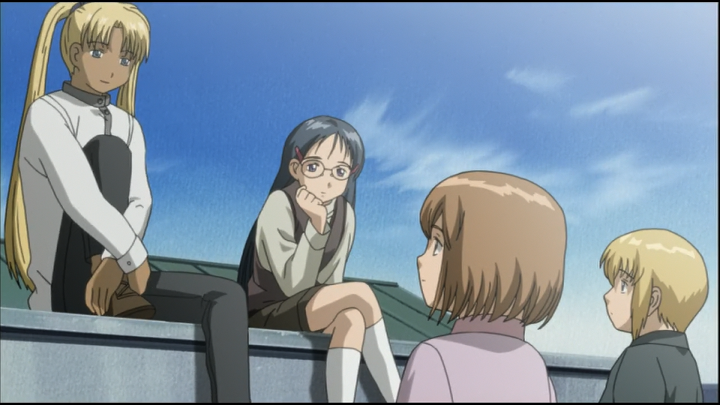
Characters
Moving on we come to the character, which are in a very similar but ultimately better place to the narrative. As I said above, a majority of Gunslinger Girl’s screen-time is dedicated to episodic character specific stories. Each one exploring their own circumstances and relationships with their own handlers. Each one looking at the same core relationship, Fratello and Cyborg, in a different. One is legitimately caring, with the Fratello looking after and pampering his charge while another may treat them like a tool, while another still may look at them with disdain. Each girl has their own idea of what the relationship should be, or what they want to get out of it, etc. This is Gunslinger Girl’s most interesting and engaging aspect, figuring out who these girls are. Sadly though, just like the animation and the story, Gunslinger Girl fails to fully execute on its vision here.
Because you see, outside of Elsa and maybe Angelica, none of the girls really have an overarching story. They don’t really change or grow or are challenged in new ways. Certainly, they are challenged in their flashbacks, in the history we see as we first meet them. But that is supposed to build up who they are now, not be a substitute for who they can then become. It’s as if they exist inside the already established relationships given to them without ever really changing the status quo except for one admittedly good arc. When you combine this with stiff voice acting, similar to the unexpressive animation on them, it hurts any interest you might have. There is an argument to be made, similar to the animation, that the VA work was done on purpose. But just like before, while interesting on paper it just doesn’t work in practice.
All in all, I really like the concept and base introductions of these characters. Their whole situation is interesting as is how each one is used to comment on that kind of relationship as a whole. Similarly, their affliction is also very compelling, knowing what they have become and what will become of them in the near future. In a way I liken it to something like say… Alzheimers patients, or the extremely old. Those who are forgetting who they are and others around them. It’s an incredibly powerful idea, one that many people have experience with a loved one in real life. But Gunslinger Girl just doesn’t execute on it well enough to make it work for more than an episode or two at a time. Maybe the 2nd season and continued manga resolves this, since it’s just part of an adaptation. But in this season, I’m left wanting.
OST/Sound Design
Next up we come to the last major section of this review: The OST and sound design. I promise, this one will be shorter if only because there isn’t much to talk about. Overall I found Gunslinger Girl’s OST… fine? I was never taken out of the moment by the OST or sound design, but neither was I ever really impressed. There is only really one song in “Tristezza” , maybe two with “Silenzio Prima della Lotta“, that I actually remember from the show. That I can remember scenes they played in and that really sold their particular scenes. The rest though, however good, never really felt like the contributed much. Don’t get me wrong, there are plenty of good pieces in this OST. The issue is just that I didn’t notice or care for them until I listened to the entire OST on its own.
That said, while the OST may not contribute much to the show, boy are some of these pieces great. “Dopo il Sogno” makes terrific use of its piano, singing and almost radio-chatter like vocals mixed with classic operatic. It’s hauntingly beautiful and certainly something I have already added to my playlists. Similarly there are pieces like “Costruzione” that, while not memorable, set the tone well. But for every standout piece I find, there is another rather generic one. Take for instance “Tema 1” or “Città” which I neither remember hearing while watching nor find particularly interesting. There is nothing wrong with them of course. But like much of Gunslinger Girl, it isn’t what’s wrong that’s holding it back but rather what is simply… meh. Simply put I was never enthralled with this OST, and while I cannot truly disparage it, neither can I really recommend it beyond individual pieces.
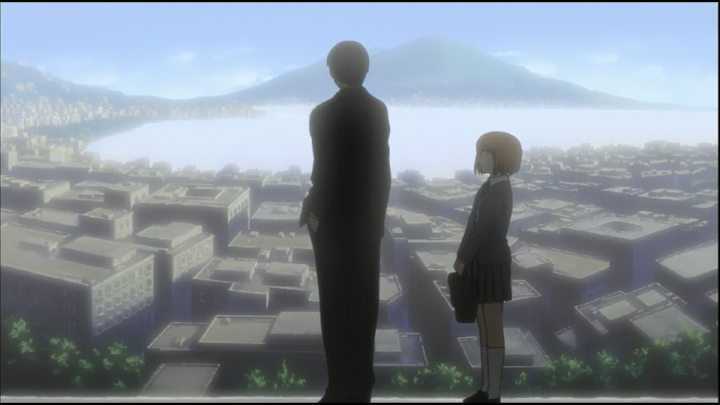
It Could Have Been More
Finally we come to the last part of this review where I talk about what Gunslinger Girl could have done better. This holds no bearing on the final score and is only about what I wanted to see as the show progressed. Why not provide some constructive criticism along with the rest, right? And fair warning, there is going to be some serious spoilers in here, so don’t read it if you haven’t watched the show. Or maybe you just don’t care, I dunno.
Click here to read the spoiler
To immediately get into it, I wanted to see more of Franco and Franca, the bomb couple. You can’t just introduce these two early on and then never actually use them for something. I don’t need Gunslinger Girl to catch them or kill them, keep them for future stories. But let Henrietta confront them, let their relationship and what they are fighting for bounce off of Henrietta. Maybe it can inspire something there, or maybe it can be used as a reveal for just how horrible the Agency’s methods are. Either way, these two had 2 relevant scenes yet were framed to make them seem far more important than they were. And really, that’s just the entire terrorist plot in a nutshell. Gunslinger Girl introduced it, set it up, but never really went anywhere with it. The greatest threat they presented was Angelica running off on her own!
Similarly, I would have liked to see more from Claes. She is introduced early, she has a compelling story and her relationship with the other cyborgs is heavily strained. Let them right, let them argue, give them emotions! This could easily be pulled into the Agency politics storyline, as these immature young girls are unable to uphold the image they need for their project. Meanwhile it can once again be used to demonstrate the effects of conditioning, and how horrible it is. Because throughout the season Gunslinger Girl is hinting at conditioning, showing us some of the after effects, but never really diving into it. What we got is fine, but it could have been more. Gunslinger Girl does this a little bit at the end with Angelica and Claes, sure. But this is resolved far to quickly for the sake of a “clean” end.
The long and short of it is that Gunslinger Girl was at its most compelling during Elsa’s murder/suicide arc. Here we finally see the negative effects of conditioning and the cyborg program. We are shown how each Fratello has their own methods and how they can disagree on what’s best for the girls. We see how important it is a Fratello treats their cyborg right, and just how emotionally unstable these girls really are. Had Gunslinger Girl played with this a bit more, either through Claes’ grief or Angelica’s desperation, there would be a much stronger narrative thread through the whole season. As it is, we just jump around between loosely connected episodic stories that sort of come together by the end, but really just feel like a season long cast introduction. I suppose what I am saying is, I wanted more things to actually happen.
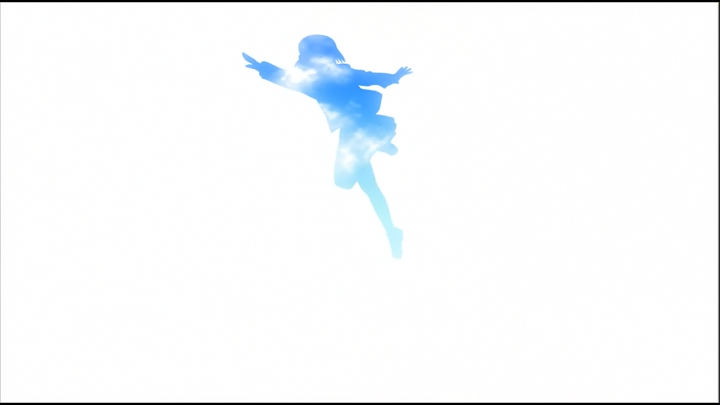
Conclusion
So all in all, how was Gunslinger Girl. Simply put, it’s a disappointment but an interesting disappointment. I had high hopes for it, it started off strong. And while it didn’t manage to meet said hopes, it was at the very least interesting. There were definitely a number of episodes I thought “This is it, this is when the hammer drops” and I was excited each time. I could tell that the series was building towards something, just not what and when we could get there. Is it a shame we never did? Yes. But that doesn’t invalidate what good there was in the show. Who knows, maybe the 2nd season takes all this setup and runs with it, maybe it really does “get better in the 2nd season”. But this review isn’t about the 2nd season. So Gunslinger Girl gets an A+ for effort, but a D for execution.
Thanks for reading everyone, and for sticking through another season of Throwback Thursday! The winner of the poll posted at the end of last weeks post was… Twelve Kingdoms, made in 2003 by Studio Pierrot! This is a long one, a whopping 45 episodes. So for the sake of time we are going to do 2 a week, maybe 3 depending on how I feel. I hope you are able to stick with me through it since its going to last into next year most likely. If you have a series you would like to see covered on Throwback Thursday, leave a comment here or send me a tweet here. And if you think I am an idiot and couldn’t be more wrong, you can let me know in the same places. See you later, at the next season of Throwback Thursday!

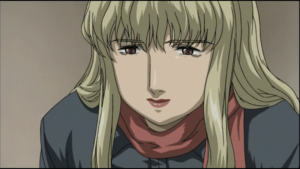
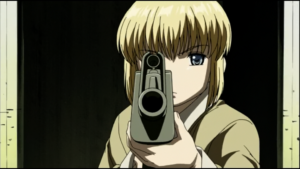
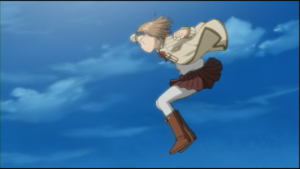
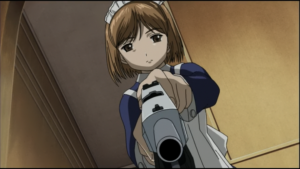
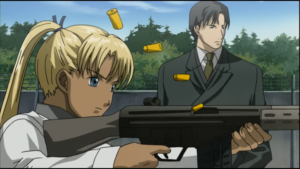
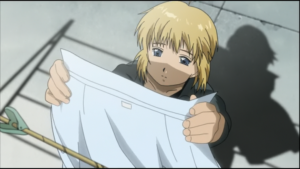
The main problem of this anime adaptation is that it picks up the manga premises and try to change it in the climax of the season to get something similar to a book end, since the manga did start with an episodic format.
After Introducing Jose and Henrietta Volume 1 of the manga opens with Jose’s investigation of the circumstances around Elsa’s death (who is never seen alive) and by chapter 5 the side effects of the cyborg treatment are already estabilished.
The story then goes around in episodic format for a while (with chapters roughly similar to the other anime episodes) properly introducing each Fratello and each of the Handler personal issues (or lack of) with the idea that their Cyborg could “go berserk”.
2nd season of the anime adapted Pinocchio’s arc so it is a bit more cohesive, though it had its own share of issues anyway. (and Triela basically ends up as the main character of S2, since she was the focus of that arc, stunting the progression of everybody else)